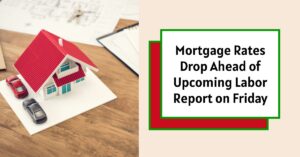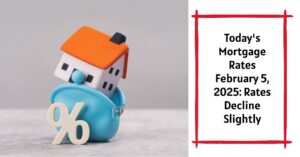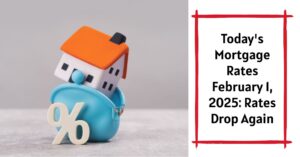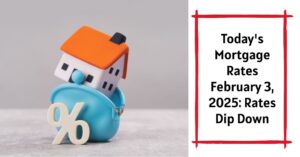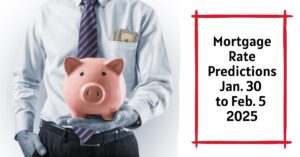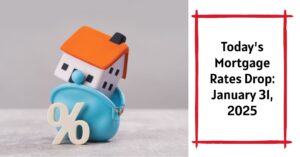Are you thinking about buying a home or refinancing your current mortgage? Well, here's something to keep an eye on. As of today, February 5, 2025, mortgage rates have dipped slightly and all eyes are on the upcoming Labor Report scheduled for release this Friday. A weaker-than-expected report showing higher unemployment could further nudge those rates downward, potentially opening up opportunities for homebuyers.
Mortgage Rates Drop Ahead of Upcoming Labor Report on Friday
Let's be real, the last couple of years have been a rollercoaster for anyone involved in the housing market. We saw historically low rates during the pandemic, followed by a surge as the Federal Reserve tried to combat inflation. It's been tough, and many potential buyers have been sidelined, waiting for some relief.
This recent dip in mortgage rates is a welcome sign, but it's important to understand the context and what could happen next. While the current movement is encouraging, external factors such as the forthcoming Labor Report and any actions the Federal Reserve might take have the potential to influence future mortgage rates.
Today's Mortgage Rate Snapshot
Here's a quick look at where mortgage rates stand today, according to Bankrate:
- 30-year fixed-rate: 6.95% (-0.05% from last week)
- 15-year fixed-rate: 6.24% (-0.06% from last week)
- 30-year fixed-rate jumbo: 6.98% (-0.05% from last week)
- 5/1 ARM: 6.15% (-0.23% from last week)
- 10-year fixed-rate: 6.07% (-0.05% from last week)
And for those looking to refinance:
- 30-year fixed-rate refinance: 6.95% (-0.07% from last week)
- 15-year fixed-rate refinance: 6.23% (-0.10% from last week)
- 10-year fixed refinance: 6.06% (-0.11% from last week)
Why the Dip? A Look Behind the Numbers
Several factors influence mortgage rates. One of the biggest is the Federal Reserve's monetary policy. The Fed doesn't directly set mortgage rates, but its decisions about the federal funds rate have a ripple effect on borrowing costs across the board.
Another important factor is the overall health of the economy. Strong economic data, like low unemployment and high consumer spending, tend to push rates up. Conversely, signs of economic weakness, such as a rising unemployment rate, can cause rates to fall. This is why Friday's Labor Report is so important. If it shows a significant increase in unemployment, it could signal a slowing economy and lead to further rate declines.
Of course, market sentiment and investor expectations also play a role. Uncertainty about the future can lead to volatility in the bond market, which in turn affects mortgage rates.
Recent Mortgage Rate Trends: A Quick Recap
To really understand where rates might be going, it's helpful to look back at where they've been. Remember those rock-bottom rates during the pandemic? That was a direct result of the Fed slashing interest rates to stimulate the economy.
Then, as inflation started to surge in 2022, the Fed began raising rates aggressively. Mortgage rates followed suit, climbing rapidly and peaking around 7% in late 2024.
Even though the Fed has started modestly reducing rates in late 2024, mortgage rates have remained stubborn.
Where Are Mortgage Rates Headed? My Prediction
Predicting the future is always a risky business, especially when it comes to the economy. However, here's my take on where mortgage rates might be headed in the coming months.
A lot depends on what happens with the Federal Reserve. The Fed has adopted a “wait-and-see” approach. This means they're likely to hold off on any further rate cuts until they see more evidence that inflation is truly under control.
If the economy continues to show signs of weakness, the Fed might be more inclined to resume easing interest rates. That would likely put downward pressure on mortgage rates.
However, I don't expect any dramatic drops in the near term. My best guess is that we'll see rates fluctuate in a relatively narrow range, probably between 6% and 7%, for most of 2025. Experts predict rates landing around 6.4% at the end of the year. I wouldn't count on them plummeting back to the levels we saw during the pandemic anytime soon.
Beyond Rates: The Affordability Puzzle
It's crucial to remember that lower mortgage rates are only one piece of the affordability puzzle. Even if rates do fall, prospective homebuyers still face other challenges, including:
- Sluggish wage growth: Wages haven't kept pace with inflation, making it harder for people to save for a down payment and afford monthly mortgage payments.
- Housing shortage: The supply of homes for sale is still relatively low in many markets, which is keeping prices elevated.
So, while lower rates would certainly help, they won't solve the affordability crisis overnight.
Choosing the Right Mortgage for You
If you're in the market for a home, it's essential to choose the right type of mortgage for your situation. Here's a rundown of the most common options:
- 30-year fixed-rate mortgage: This is the most popular choice. The interest rate remains the same for the life of the loan, providing stability and predictability. Your monthly payments will be lower than with a shorter-term loan, but you'll pay more interest overall.
- 15-year fixed-rate mortgage: With a 15-year mortgage, you'll pay off your loan much faster and save a significant amount of money on interest. However, your monthly payments will be higher.
- 5/1 Adjustable-Rate Mortgage (ARM): An ARM offers a fixed interest rate for a set period (in this case, five years), after which the rate adjusts annually based on market conditions. ARMs typically have lower introductory rates than fixed-rate mortgages, but your payments could increase significantly if rates rise after the fixed-rate period ends.
Recommended Read:
Mortgage Rate Predictions Next Week: Jan 30 to Feb 5, 2025
Here's a table summarizing the key differences:
| Feature | 30-Year Fixed | 15-Year Fixed | 5/1 ARM |
|---|---|---|---|
| Interest Rate | Higher | Lower | Lower (initially) |
| Monthly Payment | Lower | Higher | Lower (initially) |
| Interest Paid | Higher | Lower | Varies after 5 yrs |
| Rate Stability | High | High | Low after 5 years |
Calculate Your Mortgage Payment
Before you start house hunting, it's a good idea to estimate how much you can afford to spend each month on a mortgage. There are many online mortgage calculators that can help you do this. Keep in mind that your mortgage payment will include not only principal and interest but also property taxes, homeowners insurance, and potentially private mortgage insurance (PMI) if you put down less than 20%.
Tips for Getting the Best Mortgage Rate
Even in a rising rate environment, there are steps you can take to improve your chances of getting a good deal on a mortgage:
- Improve your credit score: A higher credit score generally translates to a lower interest rate.
- Save for a larger down payment: Putting down at least 20% can help you avoid PMI and potentially qualify for a lower rate.
- Pay off debt: Lenders look at your debt-to-income ratio (DTI) when assessing your ability to repay a mortgage. Lowering your DTI can improve your chances of getting approved and securing a better rate.
- Shop around for lenders: Don't just go with the first lender you talk to. Get quotes from multiple lenders and compare their rates and fees.
- Consider government-sponsored loans: FHA and VA loans often have more flexible borrowing requirements than conventional loans.
The Bottom Line: Stay Informed and Be Prepared
The housing market can be confusing, but the more informed you are, the better equipped you'll be to make smart decisions. Keep an eye on economic data, follow the Federal Reserve's actions, and don't be afraid to shop around for the best mortgage rates.
Remember, buying a home is a major financial commitment, so take your time, do your research, and don't let anyone pressure you into making a decision you're not comfortable with. Good luck!
Work with Norada in 2025, Your Trusted Source for
Real Estate Investing
With mortgage rates fluctuating, investing in turnkey real estate
can help you secure consistent returns.
Expand your portfolio confidently, even in a shifting interest rate environment.
Speak with our expert investment counselors (No Obligation):
(800) 611-3060
Recommended Read:
- Mortgage Rates Forecast for the Next 3 Years: 2025 to 2027
- 30-Year Mortgage Rate Forecast for the Next 5 Years
- 15-Year Mortgage Rate Forecast for the Next 5 Years
- Why Are Mortgage Rates Going Up in 2025: Will Rates Drop?
- Why Are Mortgage Rates So High and Predictions for 2025
- NAR Predicts 6% Mortgage Rates in 2025 Will Boost Housing Market
- Mortgage Rates Predictions for 2025: Expert Forecast
- Will Mortgage Rates Ever Be 3% Again: Future Outlook
- Mortgage Rates Predictions for Next 2 Years
- Mortgage Rate Predictions for Next 5 Years
- Mortgage Rate Predictions for 2025: Expert Forecast
- Mortgage Rate Predictions: Why 2% and 3% Rates are Out of Reach
- How Lower Mortgage Rates Can Save You Thousands?
- How to Get a Low Mortgage Interest Rate?
- Will Mortgage Rates Ever Be 4% Again?
